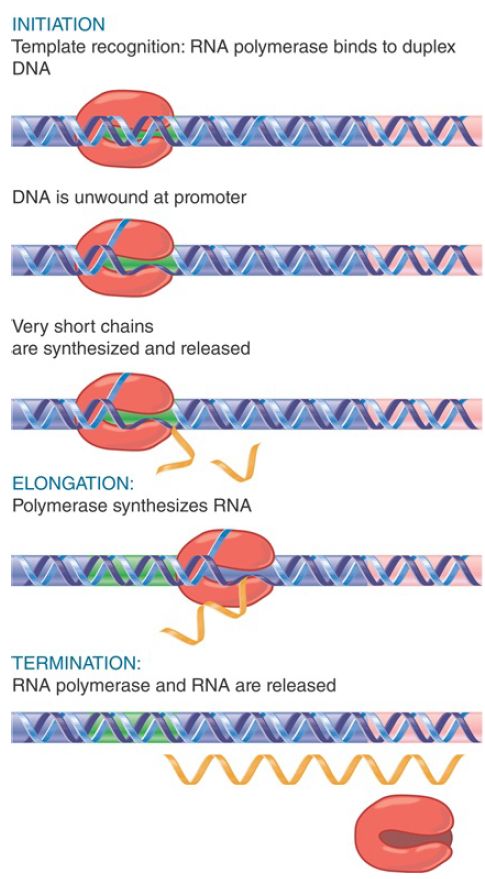


 النبات
النبات
 الحيوان
الحيوان
 الأحياء المجهرية
الأحياء المجهرية
 علم الأمراض
علم الأمراض
 التقانة الإحيائية
التقانة الإحيائية
 التقنية الحيوية المكروبية
التقنية الحيوية المكروبية
 التقنية الحياتية النانوية
التقنية الحياتية النانوية
 علم الأجنة
علم الأجنة
 الأحياء الجزيئي
الأحياء الجزيئي
 علم وظائف الأعضاء
علم وظائف الأعضاء
 الغدد
الغدد
 المضادات الحيوية
المضادات الحيوية|
Read More
Date: 27-2-2021
Date: 15-3-2021
Date: 18-11-2020
|
The Transcription Reaction Has Three Stages
KEY CONCEPTS
- RNA polymerase binds to a promoter site on DNA to form a closed complex.
- RNA polymerase initiates transcription after opening the DNA duplex to form a transcription bubble.
- During elongation, the transcription bubble moves along DNA and the RNA chain is extended in the 5′ → 3′ direction by adding nucleotides to the 3′ end of the growing chain.
- Transcription stops and the DNA duplex reforms when RNA polymerase dissociates at a terminator site.
The transcription reaction can be divided into the three stages illustrated in FIGURE 1: initiation, in which the promoter is recognized, a bubble is created, and RNA synthesis begins; elongation, in which the bubble moves along the DNA as the RNA transcript is synthesized; and termination, in which the RNA transcript is released and the bubble closes.

FIGURE 1. Transcription has three stages: The enzyme binds to the promoter and melts DNA and remains stationary during initiation; moves along the template during elongation; and dissociates at termination.
Initiation itself can be divided into multiple steps. Template recognition begins with the binding of RNA polymerase to the double-stranded DNA at a DNA sequence called the promoter. The enzyme first forms a closed complex in which the DNA remains double stranded. Next the enzyme locally unwinds the section of promoter DNA that includes the transcription start site to form the open complex. Separation of the DNA double strands makes the template strand available for base pairing with incoming ribonucleotides and synthesis of the first nucleotide bonds in RNA.
The initiation phase can be protracted by the occurrence of abortive events, in which the enzyme makes short transcripts, typically shorter than about 10 nucleotides, while still bound at the promoter. The enzyme often makes successive rounds of abortive transcripts by releasing them and starting RNA synthesis again. The initiation phase ends when the enzyme finally succeeds in extending the chain and clearing the promoter.
Elongation involves processive movement of the enzyme by disruption of base pairing in double-stranded DNA, exposing the template strand for nucleotide addition and translocation of the transcription bubble downstream. As the enzyme moves, the template strand of the transiently unwound region is paired with the nascent RNA at the point of growth. Nucleotides are added covalently to the 3′ end of the growing RNA chain, forming an RNA–DNA hybrid within the unwound region. Behind the unwound region, the DNA template strand pairs with its original partner to reform the
double helix, and the growing strand of RNA emerges from the enzyme.
The traditional view of elongation as a monotonic process, in which the enzyme moves forward along the DNA at a steady pace corresponding to nucleotide addition, has been revised in recent years. RNA polymerase pauses or even arrests at certain sequences. Displacement of the 3′ end of the RNA from the active site can cause the polymerase to “backtrack” and remove a few nucleotides from the growing RNA chain before restarting. Pausing can also be programmed to occur by the use of an RNA hairpin structure encoded in the template or sequence context–caused misalignment of the incoming nucleotide with its complementary base.
Termination involves recognition of sequences that signal the enzyme to halt further nucleotide addition to the RNA chain. In addition, long pauses can lead to termination. The transcription bubble collapses as the RNA–DNA hybrid is disrupted and the DNA reforms a duplex; phosphodiester bond formation ceases, and the transcription complex dissociates into its component parts: RNA polymerase, DNA, and RNA transcript. The sequence of DNA that directs termination at the end of transcription is called the terminator.



|
|
|
|
مخاطر خفية لمكون شائع في مشروبات الطاقة والمكملات الغذائية
|
|
|
|
|
|
|
"آبل" تشغّل نظامها الجديد للذكاء الاصطناعي على أجهزتها
|
|
|
|
|
|
|
تستخدم لأول مرة... مستشفى الإمام زين العابدين (ع) التابع للعتبة الحسينية يعتمد تقنيات حديثة في تثبيت الكسور المعقدة
|
|
|